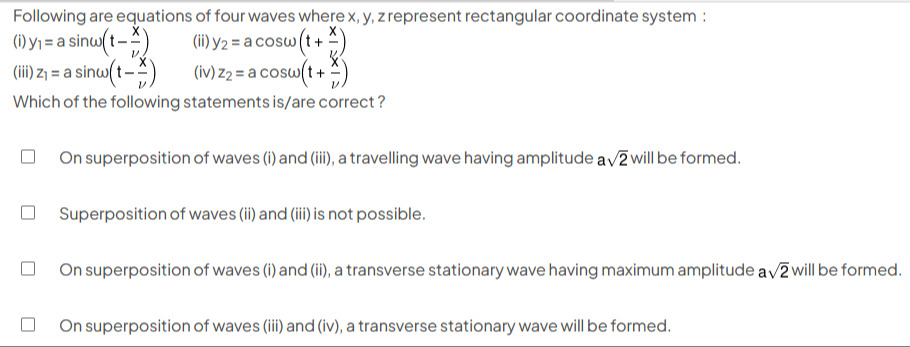Question
Question: Following are equations of four waves where x, y, z represent rectangular coordinate system: (i) $y_...
Following are equations of four waves where x, y, z represent rectangular coordinate system: (i) y1=asinω(t−νx) (ii) y2=acosω(t+νx) (iii) z1=asinω(t−νx) (iv) z2=acosω(t+νx)
Which of the following statements is/are correct?

On superposition of waves (i) and (iii), a travelling wave having amplitude a2 will be formed.
Superposition of waves (ii) and (iii) is not possible.
On superposition of waves (i) and (ii), a transverse stationary wave having maximum amplitude a2 will be formed.
On superposition of waves (iii) and (iv), a transverse stationary wave will be formed.
On superposition of waves (i) and (iii), a travelling wave having amplitude a2 will be formed., On superposition of waves (iii) and (iv), a transverse stationary wave will be formed.
Solution
The four wave equations are:
(i) y1=asinω(t−νx)=asin(ωt−kx), polarized in y-direction, travelling in +x direction.
(ii) y2=acosω(t+νx)=acos(ωt+kx), polarized in y-direction, travelling in -x direction.
(iii) z1=asinω(t−νx)=asin(ωt−kx), polarized in z-direction, travelling in +x direction.
(iv) z2=acosω(t+νx)=acos(ωt+kx), polarized in z-direction, travelling in -x direction.
Here, k=ω/ν is the wave number. All waves have the same amplitude a, angular frequency ω, and speed ν.
Let's analyze each statement:
Statement 1: On superposition of waves (i) and (iii), a travelling wave having amplitude a2 will be formed.
Wave (i) is y1=asin(ωt−kx)j^.
Wave (iii) is z1=asin(ωt−kx)k^.
Both waves are travelling in the same direction (+x) with the same frequency and phase, but are polarized in perpendicular directions (y and z).
The resultant displacement is r=y1j^+z1k^=asin(ωt−kx)j^+asin(ωt−kx)k^=asin(ωt−kx)(j^+k^).
This is a travelling wave since the phase is of the form (ωt−kx).
The direction of polarization is constant, along the vector (j^+k^), which lies in the y-z plane at a 45 degree angle to the y and z axes. This is a linearly polarized wave.
The magnitude of the resultant displacement is ∣r∣=∣asin(ωt−kx)∣∣j^+k^∣=∣asin(ωt−kx)∣12+12=a2∣sin(ωt−kx)∣.
The amplitude of this travelling wave is the maximum value of the magnitude, which is a2 when ∣sin(ωt−kx)∣=1.
Thus, statement 1 is correct.
Statement 2: Superposition of waves (ii) and (iii) is not possible.
Wave (ii) is polarized in the y-direction and travels in the -x direction. Wave (iii) is polarized in the z-direction and travels in the +x direction.
Superposition of waves is always possible as long as the waves exist in the same region of space. The principle of superposition states that the total displacement is the vector sum of individual displacements. There is no physical restriction based on polarization or direction of propagation that prevents superposition.
Thus, statement 2 is incorrect.
Statement 3: On superposition of waves (i) and (ii), a transverse stationary wave having maximum amplitude a2 will be formed.
Wave (i) is y1=asin(ωt−kx).
Wave (ii) is y2=acos(ωt+kx).
Both waves are polarized in the same direction (y-direction), have the same frequency and amplitude, but travel in opposite directions (+x and -x). The superposition of such waves results in a stationary wave.
The resultant displacement is y=y1+y2=asin(ωt−kx)+acos(ωt+kx).
Using trigonometric identities: cos(ωt+kx)=sin(π/2−(ωt+kx))=sin(π/2−ωt−kx).
y=asin(ωt−kx)+asin(π/2−ωt−kx).
Using the sum-to-product formula sinA+sinB=2sin(2A+B)cos(2A−B):
A=ωt−kx
B=π/2−ωt−kx
2A+B=2(ωt−kx)+(π/2−ωt−kx)=2π/2−2kx=π/4−kx.
2A−B=2(ωt−kx)−(π/2−ωt−kx)=22ωt−π/2=ωt−π/4.
So, y=2asin(π/4−kx)cos(ωt−π/4).
Since sin(π/4−kx)=−sin(kx−π/4), we can write y=−2asin(kx−π/4)cos(ωt−π/4).
This is a stationary wave. The amplitude at position x is Astat(x)=∣−2asin(kx−π/4)∣=∣2asin(kx−π/4)∣.
The maximum amplitude occurs when ∣sin(kx−π/4)∣=1, which is 2a.
The statement claims the maximum amplitude is a2, which is incorrect.
Thus, statement 3 is incorrect.
Statement 4: On superposition of waves (iii) and (iv), a transverse stationary wave will be formed.
Wave (iii) is z1=asin(ωt−kx). Polarized in z, travelling in +x.
Wave (iv) is z2=acos(ωt+kx). Polarized in z, travelling in -x.
Both waves are polarized in the same direction (z-direction), have the same frequency and amplitude, but travel in opposite directions (+x and -x). The superposition of two such waves results in a stationary wave.
The resultant displacement is z=z1+z2=asin(ωt−kx)+acos(ωt+kx).
This is mathematically identical to the superposition in statement 3, just with displacement along the z-axis instead of the y-axis.
The resultant wave will be z=2asin(π/4−kx)cos(ωt−π/4), which is a stationary wave polarized in the z-direction (transverse).
The maximum amplitude is 2a. The statement only claims a transverse stationary wave will be formed, which is true.
Thus, statement 4 is correct.
The correct statements are 1 and 4.
